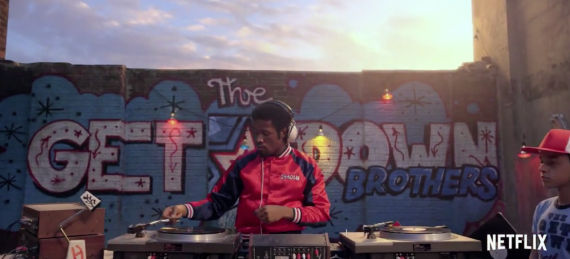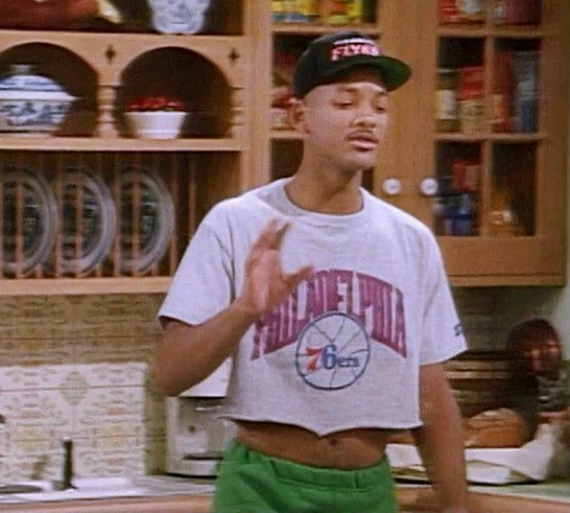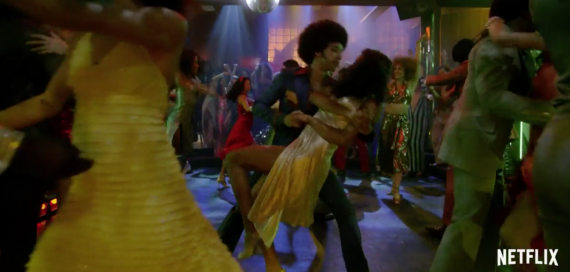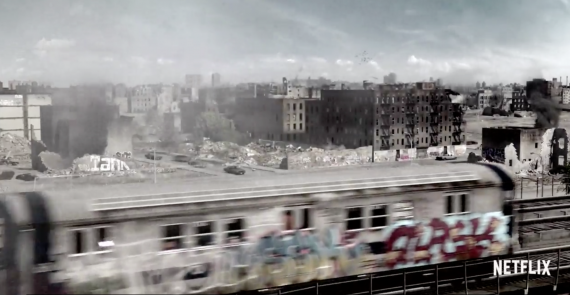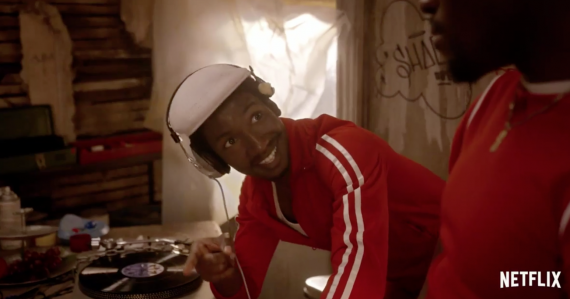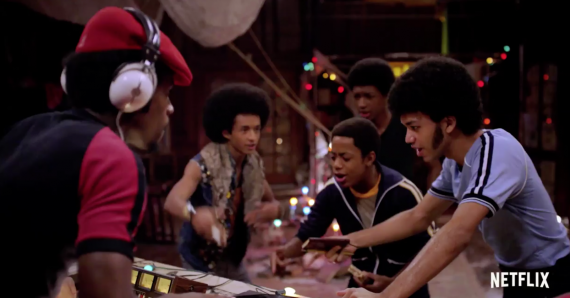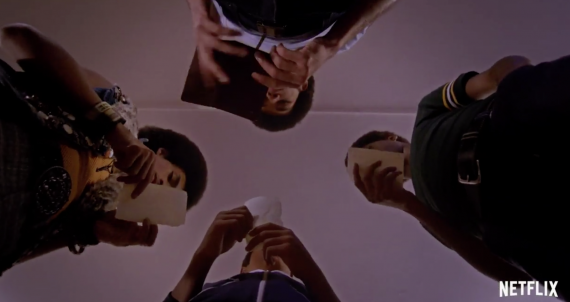#THEGETDOWN
The Get Down is Netflix new TV series that is an educational, informative and entertaining look at hip hop history. A glorious championing and romantic look at life and pop culture that shaped the hip-hop genre, with young love, ambition and fashion at it’s heart.
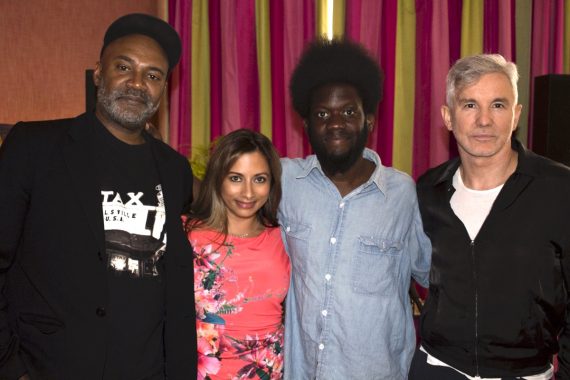
JASMINE WITH WRITER NELSON GEORGE, MUSICIAN MICHAEL KIWANUKA, AND DIRECTOR BAZ LURHMAAN.
PHOTO CREDIT – PAUL H.
At the start of my interview with pre-eminent hip-hop historian Nelson George who wrote The Get Down, and actor Jaden Smith who plays a character in the new Netflix series, I get an annoying interruption with the hotel room door banging just as I ask my first question. The clock is ticking away on my short junket time with the two men and yet here’s an interruption eating into my precious time!. Luckily, for me, its Jaden’s dad, a one mister Will Smith, apologising for barging in on us but, as he humbly explained, he’s just off a plane in London and wanted to hug his son. An interruption I didn’t mind. At all.
Will bantered with son Jaden for a minute, so as any journo would do, I took the opportunity to slip him a quick informal question too and we were off, with Jaden ribbing daddy for rocking a crop top many moons ago as the Fresh Prince, but in equal measures was clearly as proud as punch of his pops, and spoke about dealing with public life as Will’s son, with grace.
Jaden ‘’he had a crop top in the fresh prince…lol!’’
Will ‘’yeah ok! We had a lil bit of the conservation, about a half crop top….
Jaden ‘’my dad released his first record 30 years ago!’’
Will ‘’we lived it. Jaden was calling me from the set. Kurtis (Blow) is here!!!’’
(Will leaves. Jaden explains the way he deals with internet trolls)
Jaden – I really DON’T think about the public and media pressure, as you just saw I have a normal dad that just walked in here. No one’s perfect, I don’t think I’m living up to that much. I just do what I like to do. It’s things like this that make me proud of the things that I am doing, as this is going to affect culture for years and years to come. So the things that people say, it’s like ‘I’m so glad you took time to write a lil message about me on the Internet! I feel like anyone that takes time out of their life to talk about me is part of the Jaden Smith brand already, people who already say things about me are already my biggest supporters!’’
Boom! Great training from his pops who was once upon a time the biggest actor on the planet in the eighties.
Have you noticed that everything eighties has been back for a minute and not letting up? Hi top hairstyles, rah rah skirts, leggings, vinyl records, cassette players, adidas gazelles.
There’s not just a nostalgia for past fashion but also eighties hip-hop stars and their stories. NWA, hip-hop reunion tours by Bad Boy and every R&B act from Boyz II Men to Backstreet.
Stories and films around the black communities historical experience have been numerous this past decade with biopic stories for Mandela, Selma, NWA, 12 Years a Slave, Roots and many more. However annoyingly for many, these stories were often about specific people and focused on their stories of overcoming oppression. No wonder Snoop threw his toys out of the pram at yet another huge Hollywood remake of Roots.
But this week a new kids in town and it goes by the name The Get Down and its one story Snoop’s sure to love. The series is a mythic saga of how New York at the brink of bankruptcy gave birth to hip-hop, punk and disco taking in the Bronx tenements, the SoHo art scene, CBGB, Studio 54 and the just-built World Trade Centre.
It’s an exciting, panoramic look at the scene around the south Bronx and the birth of hip-hop and its early characters, some real, some fictional. It’s a lightly fictionalised story of the time just before hip-hop that led to its birth. A time when disco was the thing and how it segued into this thing we now know as rap.
Rap historian Nelson George told me parts of the storyline like a crew name and a much-coveted record had to be invented. For example ‘’Shaolin and the Pucusa record doesn’t exist, so we used these fictional things that were actually based on real conversations. We sat with Kurtis Blow, Kool Moe Dee, Herc, Flash and a lot of breakers, graf artists and out of their life experiences we created this’’.
THE MOVES
The show is named after an old funk term for the section of a record that makes people dance. “You don’t know what the fucking get down is?”. So naturally, there is a lot of dancing, and it’s infectious!
That dance that the kids do nowadays at all the parties is to the candy song aka a basic electric slide style dance performed to the song Candy by the soul funk band Cameo. You know the one. Its roots are entrenched in disco, a million other versions of the electric slide and two-step dances from back then, and the eighties resurgence movement doesn’t just stop there. The second cornerstone pillar of the hip-hop genre- graffiti- is hot again too.
In the same way we eighties kids were brought up on Breakdance and Beatstreet films, (I wonder if todays millennial generation have even heard of these classics) I know The Get Down will resonate with youth today.
Remember the scenes in Beatsteet where the graffiti artists will stay up all night spraying the trains, only to wait up all day the next day just for a glimpse of one passing by on a bridge with their name tag on it for their moment of euphoria? And the train would be cleaned and the artwork gone within hours. All that passion and work by the graf sprayers knowing the train will be washed off with no longevity? Imagine today’s kids bothering with that? Put up and gone in a second. Was graf the eighties version of Snapchat?
The Get Down Director Baz Lurhmaan brings the hot, acrid, hostile, broken down and beaten up, violent, cash strapped, dying. mind blowing scenes of the time to life with eye popped colours, swooping crane shots and stunts akin to kung fu movies. It’s like watching a music video on steroids. Not totally surprising when you consider that like many directors before him, Australian Luhrmann came to movies via pop videos. Remember his classic Wear Sunscreen’’?
Baz brought huge, mesmerising spectacle when he directed Moulin Rouge, The Great Gatsby and Romeo & Juliet and The Get Down also has all his traditional hallmarks. Apparently Luhrmann first had the idea for the show 10 years ago so a decade of love, research and passion has gone into this. The series is based around the summer of 1979 when “Rapper’s Delight” appeared, and by the start of 1980, three hip-hop records had reached the top 50. The rest of the story is told through the lives and music of the South Bronx kids who changed their city, and the world…forever.
THE STYLE
The Get Down has scenes that include high-paced action, rip -oaring comedy; matrix style martial arts juxtaposed with massive music tracks and high school love story vibes. The episodes encompass every genre that you love to love. Fight action, parkour action, comedy, stunts, SFX and a booming panoramic soundtrack.
Like many kids in the seventies and eighties who came up on hip-hop culture it wasn’t the rappers that drew us in first. Yes, we learnt line for line lyrics from Rappers Delight, electro classics and more but it was the breakdancing and DJ’s that initially caught our hearts. We learnt to body pop and breakdance and everyone knew someone who was a DJ, break-dancer or spray painter.
Everyone in the eighties was a kung fu and superhero fan and no one more so than hip hop music lovers. Kung-Fu films introduced a racially charged America to see beyond black and white. Rap stars and fans picked names that reflected this. Grandmaster Flash, Kool Herc, DJ Red Alert, Furious Five, Wu Tang Clan. As for B-boys and B-girls, so much of their quest for mastery, dedication to the battle, and strategy in combat was rooted in the martial arts. The windmill, the Wu tang, the swipe, the battle uprock, freezes, air flares and more.
The Get Down characters are immediately engaging and accessible, all wearing the bright, lurid colours that were the fashion back then. The outfits are in your face spangle, lycra sequins, platforms, feather coats, pimptastic, disco fab works of art. Converse and Puma kicks with knee high socks, basic tee shirts and afros. In fact, the props master must’ve had a nigh impossible yet fun task of sourcing outfits.
The Get Down brings back all the nostalgia for hip-hop lovers in the early days. Remember before cheap flights and the world being connected via the Internet? If anyone you knew was flying out of London to New York they would be laden down with trainer and music orders from all their friends?
Remember when our parents kept the plastic protective layer on our sofas for years? Well we hip-hop lovers did that with our sneakers. Whitener and shoe cleaning brushes were as important to us as toothpaste and toothbrushes. Much to the anger of our mums who would periodically yell ‘’get those trainers out of my sink!’’ Even in 2016 you’ll be hard pressed to find a hip-hop-head in a festival ruining his sneakers with mud without the aid of a grocery store bag. It’s the total polar opposite of Indie kids love their kicks so battered that their soles are flapping off. Hip-hop kids want our sneakers box fresh.
For The Get Down series, name brands like Puma, Converse, and Pro-Keds, agreed to remanufacture the seventies styles especially for the show, some of the sneakers that costume designer Catherine Martin calls “the foundation of the era’s style.” And the franchise is already making commercial gains as I’m told the vintage-model sneakers will be rereleased onto the general market later this year.
Remember when everyone wore a branded tracksuit like Sergio Tacchini or Kappa and had their ‘’street names’’ printed on the back?
Remember when we accessorised our own designer tracksuits and denim jackets with our ‘’street tags’’ on the rear? I had Minnie Minx after The Beano character for years on my back. Back then you would pay Graf artists to paint designs on denim jackets. We wanted our name in graf, our area in graf, some of us even had our bedroom walls graffed up. Amazingly, In The Get Down, one of the most famous graffiti writers of the era, New York’s Lady Pink, personalised clothing for the characters.
THE CREW/CAST
Luhrmann says he wanted to approach the early days of hip-hop through a group of characters, rather than following the biography of a single real-life participant. Most of the cast are unknown rising talent, plucked out of obscurity, which is beautiful as nothing distracts from the narrative of the series, the story of hip-hop or the rag tag group of teenagers running wild in the streets of the Bronx in the late 70’s.
Several founding fathers of hip-hop are mentioned and played in the show by younger actors. In fact, at the screening Grandmaster Flash played a set for us before we watched the first episode and told us that he and some of his early peers had served as advisors for the time, and their stories make it as authentic as you can get. He had us laughing as he recalled that they even had to school the actors on how they used and held the microphone back then, totally unlike the nineties rappers.
Jaden Smith co-signed this point by telling me
‘‘ I learnt so much more about hip-hop during this experience. I learned about how people rapped back then, its one thing to think you know how to rap or spray, but then you rap and spray with Herc or Lady Pink so it’s a whole new experience. Working with Rahiem and Flash, learning about Kool Herc, …with all these things you always hear just about New York, New York, but not specifically about the Bronx, and even then the south Bronx. I have a newfound respect for it, and awareness and an understanding. I don’t think todays trap kids don’t not respect the movement, but they just don’t understand it’’.
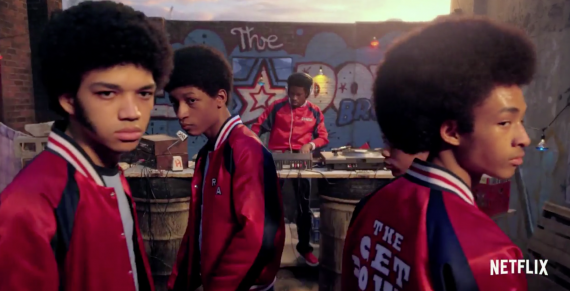
JADEN SMITH, (RIGHT), PLAYING DIZZEE IN THE GET DOWN.
Jaden has been doing press rounds for the series. His part is by no means one of the main characters, but he jumped at the chance to be involved.
Jaden- ”what attracted me was the ensemble cast and the diversity that the show had and I knew it would impact culture in a crazy crazy way because of how visionary Baz is and with what he was trying to tackle was very important to me as well, I wanted to be a part of it, it just sounded great, music, dance, art, the origins of hip hop, the death of disco. It sounded epic!’’
Asked if he had to audition for the part Jaden stutters ‘
’I pretty much did audition for it, but it was over the phone and just a conversation with Baz to see how involved with it I could be and how passionate I was about it. It was like a passion audition’’
. (lol. Parental privilege!)
Grandmaster Flash is an associate producer, and if you’ve been in the industry long enough to hear the stories of how difficult he can be to work with, then you know he was only going to take part if his star and reputation as a founder in the genre was to be honoured correctly. At the London screening he told us ‘’so many people only want to know about the cake, but no one wants to know about the ingredients’’. That quote there says it all. He speaks for most of his peers from the era I imagine. The founders who laid the path but got no financial compensate for it, only for future generations to live the high-roller life whilst many of the forefathers today live meagrely.
I cannot imagine the heat and diplomacy the writer and friend of the forefather’s of hip hop, Nelson George, must’ve had to deal with when it came to the old skool legendary names. Who’s story would be told? Who would get a name check? That’s a whole United Nations level of diplomacy and potential for hip-hop beef if ever there were one.
Nelson revealed
‘’ when we first met with Baz, the main characters that came were Shaolin and Mylene, but as we met more people it developed, Dizzee’s character wasn’t in it at the start. Rah Rah and Boo-Boo was created to service the storyline of graffiti…. almost all of the old skool artists thought that their story should be the story, but the wisest decision Baz made, was to NOT make it about one character’s story because then you felt locked into their story, but its about scope, there was a lot going on”.
THE MUSIC
The sound track for The Get Down is a mix of period hits and new tracks: Luhrmann enlisted artists such as Nas to write in the style of the time, and even many of the series’ disco “hits” are new. Nas. Always respected and underrated. This is his Empire / Timberland moment. Nelson is clear that hip-hop cultures impact on the planet has been vast.
Nelson –
”the most important thing is that when you look at hip hop has given to the world , rhyming, dj’ing, graff, breaking…you go anywhere in the world where u go where there are people that are young, angry and disenfranchised, that could be in Prague, Brazil, Columbia, Tokyo, Korea. This form has been embraced by people all over the globe as a way to say the things that can’t get said otherwise, and so no mater what happens in The States as a commercial thing, as a folk expression, nothing’s like this, cos any kid can get on the mic and rhyme, breakdance or graf , I’ve seen amazing pieces in Zurich Rio, …’’
It can’t be denied that hip-hop has shown the world much. Exposed stories, built empires, some say it even helped elect a black president. So then it brings about the question; with the reemergence of the #blacklivesmatter movement and the globalisation of hip-hop culture – a genre – arguably founded upon the experiences of young, disenfranchised black men, why are black male lives still seemingly worthless?
Nelson –
‘‘hip hop was created by more than just the African American as well as Latinos and more, and that cannot be underestimated and that’s very important to say. There’s a part of hip-hop, an ultra masculine, hyper bombastic depiction of life, that’s sometimes has got out of control, and then affects how people react to us. So there is an element of that in it. But what other vehicle has ever been there for a mass audience to hear the unbridled thoughts of these men and women?
We have great literature like Toni Morrison, we have great filmmakers, but boom, here we have boom, a guy can go into a room and express himself, boom! it goes across the globe, that’s never been done and black people have never had that kind of access. I think there’s negativity in individual things about it, but I think overall its impact on the globe has been positive’’.
With Netflix slowly taking over the world in more than 140 countries, this story is going to feed the current and past hip hop generations and fill our appetite. We have eaten, and continue to eat from the hip-hop cake and now we will know exactly what it took to make it.
The Get Down premiers August 12th on Netflix

